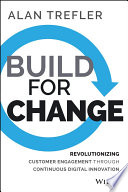

The first key idea of 'Build for Change' is the importance of agility in today's fast-paced business environment. Organizations must be able to pivot quickly in response to market changes, customer feedback, and technological advancements. The book emphasizes that traditional business models, which are often rigid and slow to adapt, can hinder growth and innovation. By adopting agile methodologies, businesses can foster a culture of experimentation and continuous improvement. This involves breaking down silos, encouraging cross-functional collaboration, and empowering teams to make decisions. The authors provide practical strategies for implementing agile practices, such as iterative development cycles, regular feedback loops, and the use of data analytics to inform decision-making. This shift towards agility not only enhances responsiveness but also improves overall employee engagement and satisfaction, as teams feel more empowered and involved in the change process.
Continue readingAnother central theme of the book is the necessity of customer-centric innovation. The authors argue that successful organizations prioritize understanding their customers' needs and preferences. This involves not just gathering data but actively engaging with customers to gain insights into their experiences and expectations. The book outlines various methods for fostering customer-centricity, such as design thinking, user testing, and feedback mechanisms. By placing the customer at the heart of the innovation process, businesses can develop products and services that truly resonate with their target audience. This approach not only drives customer loyalty but also positions organizations to anticipate market trends and stay ahead of the competition. The authors share case studies of companies that have successfully implemented customer-centric strategies, illustrating the tangible benefits of this approach.
Continue readingThe book highlights the critical role of technology in enabling change and driving innovation. In an era where digital transformation is reshaping industries, organizations must leverage technology to enhance their operations and customer offerings. The authors discuss various technological advancements, such as artificial intelligence, machine learning, and automation, and how they can be integrated into business processes. They also emphasize the importance of staying informed about emerging technologies and being willing to experiment with new tools and platforms. By harnessing technology effectively, organizations can streamline operations, improve efficiency, and create more personalized customer experiences. The book provides a roadmap for assessing technological needs, investing in the right tools, and fostering a culture of innovation that embraces technological change.
Continue readingCreating a culture that is receptive to change is another key idea presented in 'Build for Change.' The authors argue that for organizations to thrive in a dynamic environment, they must cultivate a mindset that embraces change rather than resists it. This involves fostering psychological safety, encouraging open communication, and promoting a growth mindset among employees. The book outlines strategies for leaders to model change readiness, such as being transparent about challenges, celebrating successes, and providing opportunities for professional development. By building a change-ready culture, organizations can enhance resilience, adaptability, and overall performance. The authors provide insights into how to assess organizational culture and implement initiatives that promote a positive attitude towards change.
Continue readingThe importance of strategic collaboration is another major theme in the book. The authors emphasize that no organization operates in isolation; partnerships and collaborations are essential for driving innovation and achieving strategic goals. They discuss various forms of collaboration, including cross-industry partnerships, alliances with startups, and collaborations with customers and suppliers. The book provides frameworks for identifying potential partners, establishing mutually beneficial relationships, and managing collaborative projects effectively. By leveraging the strengths and resources of others, organizations can enhance their innovation capabilities, access new markets, and create value for their stakeholders. The authors share examples of successful collaborations that have led to significant breakthroughs and competitive advantages.
Continue readingEffective leadership is crucial during periods of change, and the book provides insights into what it means to be a change leader. The authors argue that leaders must not only communicate a clear vision for change but also inspire and motivate their teams to embrace it. This involves demonstrating empathy, being approachable, and actively listening to employee concerns. The book outlines key leadership traits that are essential for guiding organizations through change, such as resilience, adaptability, and decisiveness. Additionally, the authors emphasize the importance of leading by example and being willing to take calculated risks. By embodying the principles of change leadership, leaders can foster trust, build commitment, and drive successful transformations within their organizations.
Continue readingThe final key idea revolves around the importance of measuring success and learning from failure. The authors stress that organizations must establish clear metrics to evaluate the impact of their change initiatives. This includes not only tracking financial performance but also assessing employee engagement, customer satisfaction, and overall organizational health. The book encourages a mindset of experimentation, where failures are viewed as opportunities for learning rather than setbacks. The authors provide practical advice on how to conduct post-implementation reviews, gather feedback, and iterate on processes and strategies. By embracing a culture of measurement and learning, organizations can continuously improve and refine their approaches to change, ultimately driving long-term success.
Continue reading